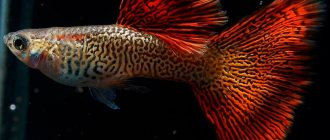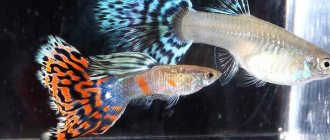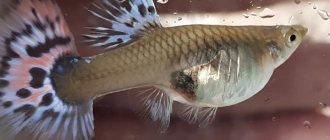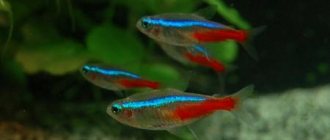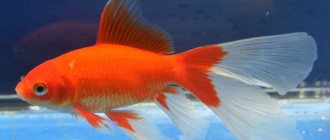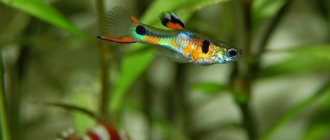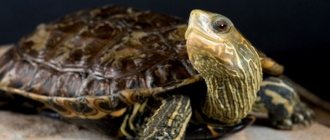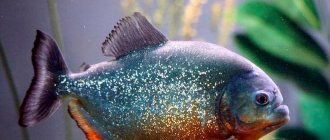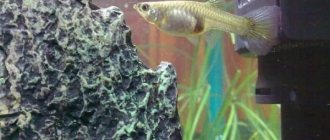Breeding guppies is one of the easiest in aquarium farming. These fish easily reproduce both in their natural habitat and in artificial home ponds. But knowledge of the features of this process will help preserve and raise healthy offspring.
- 1 Features of the species
- 2 Sexual characteristics
- 3 Features of breeding
- 4 Pregnancy
- 5 Mr. Tail Explains: The Birth Process
- 6 Raising young animals
- 7 Why guppies don't reproduce
The necessary conditions
Reproduction of guppy fish is a natural process that does not require special human intervention. However, for the best result, it is worth considering a few points:
- Water having a hardness of no more than 15 units, as well as water acidity not exceeding 8.5 Ph.
- The water temperature should be at least 25oC, so the fish move closer faster.
- Maturity of fish.
- Consumption of live food that contains proteins.
The presence of lighting plays an important role - it illuminates the bright tails of males to attract females.
How do guppies mate?
You will immediately notice if the fish begin their mating season. During this period of time they move faster than usual. Males actively pursue the female and approach her from the side or below. It is important to take into account that there should be fewer males than females, otherwise the males can drive the female to death. That is, for one male there must be at least 2 females.
How fish reproduce: guppies actually mate using a movable anal fin in the form of a tube on the male, which is called the “gonopodium.” Fertilization occurs in the female's abdominal cavity, where seminal fluid penetrates. Afterwards, it is stored in the mother’s body for a long time, so the female can be fertilized several more times without the presence of a male.
Matching
Guppies can only interbreed with members of their own species. There are a large number of breeds of these aquarium inhabitants. In order to get the desired offspring, you should learn to distinguish between them, or when purchasing, seek advice from a specialist.
The most widespread breeds are:
- scarlet;
- Berliners;
- Moscow blues;
- blue-green;
- mesh;
- carpet
There are also countless rare breeds that can only be purchased at exhibitions. Such individuals are quite expensive and have beautiful colors.
To consolidate breed characteristics, it is necessary to keep selected individuals separately from others.
If there is a need to obtain offspring from two specific individuals, then it is worth making sure that the female is virgin, since the sperm of the previous male can be stored in the fish’s body for a long time. After mating, a female guppy can give birth several times.
Guppies often breed uncontrollably. To avoid this phenomenon, it is worth keeping boys and girls separately. This will allow you to choose the most beautiful representatives and get high-quality offspring from them.
If in winter the temperature in the aquarium is maintained at +18 C, this will make it possible to pause reproduction. The female’s body will rest and recover after childbirth.
Avoiding cannibalism
These aquarium fish, unlike others, lack maternal instinct. Guppies are cannibal fish, so after giving birth, the female can safely eat her offspring. To avoid this situation, after birth it is worth separating the fry from the mother, if the spawning took place in a separate vessel. Special internal aquarium tanks are organized. If spawning took place in an aquarium with other fish, you should provide the fry with places where they can hide from large individuals: add various algae, driftwood, and stones to the aquarium.
With good and sufficient nutrition, you can completely wean guppies from cannibalism.
The fish reach sexual maturity at the age of 4-5 months.
Sex differences
Guppies exhibit pronounced sexual dimorphism. It is very, very easy to distinguish a female from a male. Males are smaller, slimmer, they have a large caudal fin, and the anal fin has turned into a gonopodium (roughly speaking, this is a tube with the help of which male viviparous fish fertilize the female).
Females are larger, have a large and noticeable belly and are usually quite pale in color.
Even juveniles can be distinguished quite early; as a rule, those of the fry that first began to color will be males.
Pregnancy period
Since guppies are viviparous fish, their embryos develop inside the mother. The gestation period ranges from 20-45 days, most often the gestation period lasts a month. How long a guppy's pregnancy will last depends on external factors such as water, nutrition, water temperature, as well as internal ones: the age of the female. So, young fish have a longer lifespan than older fish.
The water temperature has a strong influence: the higher it is, the faster the guppy will give birth. However, if the temperature is too high, there is a high risk of the birth of premature fry, and if the temperature is too low, the fry will be underdeveloped. During pregnancy, it is worth maintaining a stable external environment; you cannot change water in large quantities, otherwise this can lead to stress for the pregnant individual, which in turn can lead to a miscarriage.
Determining pregnancy in guppies
A pregnant guppy can be distinguished from others by several characteristics:
- Behavior. She becomes aggressive towards other fish, does not allow males to approach her, begins to eat more, tries to hide, and seeks solitude.
- Appearance. Her abdomen becomes larger, rounded, closer to childbirth - rectangular and a black spot is visible below. The back bends, the head next to the abdomen seems small, such a sharp change is called a “step”.
In the early stages, especially for beginners, it can be difficult to identify a pregnant guppy, but if you carefully monitor the appearance of these signs, you can easily track the progress of pregnancy.
Is it necessary to remove the female for childbirth?
During pregnancy, it is important to recognize the moment when it is necessary to remove the guppies for childbirth. After the fish has a strong black spot and the anus increases in size, it is worth placing the female in a separate aquarium or placing it in a fish tank (a special tray placed in a common aquarium). In such conditions, she will not feel stressed by the presence of other inhabitants of the common aquarium.
In a separate aquarium, the same conditions should be created, for this you need to fill half with water from a residential aquarium, and fill the other half with fresh water of a similar temperature - this way the female will not feel the changes and will not experience stress.
On a note! The aquarium should be 10-15 liters, without soil, with a variety of plants. However, a three-liter jar with the same conditions may be suitable.
Guppy pregnancy ranges from 20 to 45 days
Behavior before childbirth
Immediately before the birth itself, the female's behavior will change. Before giving birth, the guppy eats little or refuses to eat, often belching food. He doesn’t move much and gets cold, so he looks for a warmer place and often stays near the heater. If the female is left to give birth in a common aquarium, then she will hide on the bottom, hide from other inhabitants, otherwise the males will chase her and push her head into the stomach.
How does childbirth occur?
The owner should know how guppies reproduce at home in order to control the situation. Labor begins when the pregnant guppy freezes and her tail begins to tremble, usually at night or in the morning. Since the guppy carries the fry in the abdomen, during childbirth they swim out one after another, or in small groups, and are distributed throughout the aquarium, hiding so as not to be eaten.
Childbirth lasts from 1 hour to 12 hours. You can speed up this process by gradually adding fresh water and increasing the water temperature by 2-4 degrees. A male can also contribute to the birth; in extreme cases, he can be placed with a pregnant female, but after the onset of labor he should be placed back.
Postnatal behavior of the female
After giving birth, the guppy quickly comes to its senses, its behavior becomes normal: it becomes active, searches for food and can become pregnant again. After giving birth, it should be immediately moved to a common aquarium and separated from the juveniles in order to preserve the offspring. You can divide the container with a lattice, with small holes through which a large individual could not swim, unlike fry. The offspring are born capable of life without a mother, so her presence and attention are not required, all this falls on the shoulders of the owner.
The fry are born quite independent
Prenatal behavior and childbirth
Just before the onset of labor, females become inactive, tremble, lose appetite, and some vomiting may also occur. In the aquarium, they try to constantly stay close to the heater.
Guppy labor usually begins at night or in the morning and lasts for several hours or even the whole day.
During the process of giving birth, the female’s tail either begins to tremble strongly, or she completely freezes. Some of the emerging fry immediately move actively, others are inhibited and lie down on the moss or bottom.
There's nothing wrong with that, they just need to gain a little strength.
The female can be returned to the general aquarium a day after giving birth.
Sometimes females cannot give birth to fry on time.
To induce labor, you need to replace the water in the aquarium by half the volume, increase its temperature a few degrees above normal and add a male.
Caring for fry
In the first stages of a fry’s life, it is important not only to protect them from being eaten by their mother or other large individuals, but also to provide them with good conditions and high-quality nutrition. This way you will get beautiful and healthy offspring of guppy fish.
It is important to monitor the quality of water and enrich it with oxygen using an aerator, and change it often. The fry need dense vegetation, which helps them hide from larger fish. Plants such as hornwort, nayas, elodea, Java moss, pistia, and riccia are often used.
Important! The fry need a balanced diet; any small food is suitable for feeding them.
How many fry can be born
It is impossible to determine the exact number of guppy fry born, as this is influenced by several factors:
- female size;
- number of previous births;
- age of the female;
- conditions of keeping and feeding.
The older, larger and more experienced the fish, the more offspring it will be able to produce. The largest recorded number of fry is 180. It is generally impossible to accurately count the offspring due to cannibalism. The first spawning is characterized by 15-20 fry.
Determination of gender
You can determine the sex of fry after 1-3 months after birth. They acquire their own distinctive characteristics, by which individuals can be easily sorted.
At the age of a month, female guppies develop a characteristic black spot near the anus. It is worth knowing that it appears unevenly in different individuals, so it is worth observing the fry for up to 1.5 months to be sure. When breeding purebred guppies, the females should be placed in a separate aquarium, which will protect them from active males and preserve the necessary characteristics of the breed. Should be kept separately until puberty.
Males are characterized by the appearance of a gonopodium formed from the anal fin. By the time of puberty, males are smaller in size and acquire bright colors, unlike females.
The mother must be removed from the nursery after giving birth
The first days of the fry
The fry are born already formed, their length on average is at least 5 mm. After birth, the fry swim to the top to take a breath of air that will fill their swim bladder, and then dive to the bottom and hide. The first five days of juveniles require a lot of attention and special conditions. The water temperature should be kept at 28 degrees and after 3 days gradually reduced to 24. The water should be changed periodically, 30-40% of the entire container.
Note! In the first week, you need to keep the aquarium illuminated around the clock, which will contribute to the rapid growth of the fry. You need to put a filter in the aquarium and get rid of the soil that will interfere with the purification of the water.
At first, feeding is carried out all day: the full daily food intake is divided into 6 meals. And after 1-2 weeks it is worth reducing the number of meals to 3 times.
What to feed the fry
Live dust, rotifers, and microworms are usually used for food. You can also feed boiled, pureed and diluted chicken yolk in water. Special feeds are produced on a large scale that are suitable specifically for fry. And starting from the second week of life, they are gradually transferred to adult food.
Well-balanced and high-quality food will enable the fry to quickly grow up to 2 centimeters in length. At this size, they can already be transplanted into a common aquarium. This will also affect their color, making it brighter and more interesting. It is important not to overfeed the fish, and also not to pollute the water with food. To avoid this, you can use dry daphnia powder as food, which will remain on the surface of the water and be easily collected by the fish.
For the first feeding, only live food is used
How long do fry grow?
Depending on the care, quality of conditions and feeding, the period of maturation and formation of the fry will increase or decrease. If all the rules are followed, the fry will develop into large fish within 3-5 months. Then they themselves can give birth to their offspring. It is important to separate females from males at puberty to avoid early pregnancy and later sickly offspring.
It is important to take into account and monitor the fry, since their growth is individual, it is necessary to separate the already grown individual from the rest in time in order to protect them.
Attention! When the fry reaches 1.5-2 centimeters, it can be transplanted; it will not be food for large guppies.
Keeping in a home aquarium
Despite the unpretentiousness of these fish, keeping them requires compliance with certain rules. You need to know how to breed and maintain them. Guppies do not need a very large container; a 15-30 liter aquarium for 6 - 8 fish will be enough for them. You can keep them in a community aquarium, but only with peaceful and non-aggressive neighbors. They do not require additional filtration and aeration of water. However, you will have to frequently clean the soil and change the water. If the fish jump out of the water and swallow air, it means that the aquarium is overcrowded or the water quality has deteriorated. Therefore, attention should be paid to changing the water; this should be done approximately 2 times a week. Of course, you can only add settled water. Artificial lighting is not necessary.
For beauty, it is recommended to use plants with small leaves, and not too densely. If guppies are kept in a community aquarium, the fry will be able to hide in the thickets of plants. Excess plants change the pH of the water, which can harm the health of the fish. Indian fern is great.
As for feeding, you need to remember that these fish are prone to gluttony, and may even die because of this. Therefore, you cannot overfeed them. Almost any food is suitable for guppies, but it is better to diversify the feeding, in this case the color will be brighter and more saturated. They can withstand a hunger strike even for a whole week, it will not harm them.
Recommendations for proper breeding of guppies
For beginners, guppies are a suitable breed of fish, as they do not require special care and conditions. However, to breed beautiful and healthy offspring, it is important to know the basic rules for breeding fish at home. Sometimes there are situations in which guppies do not reproduce or, on the contrary, often reproduce. Then it is important to understand what the problem is and quickly eliminate it in order to achieve a solution to the issue. Often simply observing the behavior of the fish will help the owner understand and solve the problem. Then watching fish becomes not only a calming, but also an educational activity.
For successful reproduction, it is necessary to monitor the cleanliness and quality of water.
Why don't guppies reproduce?
Aquarium guppies are very prolific, so when reproduction does not occur within 1-2 months, it is worth considering. Reasons for this situation:
- All fish in the aquarium are same-sex.
- The female is pregnant, but does not yet show the first signs or they are not noticeable to the owner.
- Guppies reproduce, but are quickly eaten by their mother or other fish.
- The fish are stressed due to overpopulation and are therefore unable to reproduce.
- The female's body is not ready for fertilization, as it does not receive enough food.
- The water does not change for a long time. There is no increase in water temperature that could promote reproduction.
- Overfeeding your fish is just as bad as starving them. Obesity of internal organs prevents reproduction.
How often do guppies give birth?
Guppy fish give birth once every 2 months. To avoid overpopulation, you can separate the females from the males. However, this may also have no effect, since the female guppy can still give birth for months without a male. In this case, you can not make any efforts during pregnancy and let the female eat the fry.
Compatibility with other fish
Peace-loving and non-conflict guppies get along best with close relatives from the poeciliaceae family. Guppies are defenseless against other fish, and no matter who you place them with, arrange shelters - dense bushes of plants.
The table shows the compatibility of guppies with other fish.
| Compatible |
|
| Limited compatibility |
|
| Not compatible |
|
When choosing neighbors, also take into account the similarity of living conditions, feeding and dimensions of the aquarium. Introduce the fish at the same time, this will reduce the risk of conflicts over territory and food.
Reviews
Guppies are beautiful and unpretentious aquarium fish; it is a pleasure to breed them and watch them. With proper and successful breeding of guppies, it is possible to carry out selection work, obtaining specimens of a pure breed with an interesting color and original hybrids by crossing with other species. But if you want such results, you need to understand how they reproduce and monitor it. Responsibility for overpopulation or death of fish lies entirely on the shoulders of the owner. By the way, their health also needs to be carefully monitored, because guppies do not always tolerate diseases well, but this is a topic for another article.
Would you like to buy a Guppy for your own aquarium? Share in the comments!
Features of the species
Small aquarium fish of the genus Poeciliidae are distinguished by a variety of species. Multi-colored flocks of different colors and shapes of plumage decorate any aquarium.
All species of these viviparous fish reproduce equally, but some are more capricious in terms of care conditions. These are predominantly albinos and individuals of white and pale lemon color, for example, yellow blond.
Guppies with a natural gray color are the most hardy and unpretentious, so for your first breeding experience you should choose not the most exotic elite pets.
It is better for beginners to start breeding guppies with the following species:
- round-finned;
- short-finned;
- large-finned;
- Egler's guppy;
- lyrebirds.
In order for a couple to produce offspring, the male and female must be of the same type. If the first experiment is successful, you can think about selective breeding, since these particular fish are capable of producing pure samples of the breed and are not prone to mutations.
Pregnant female guppies
